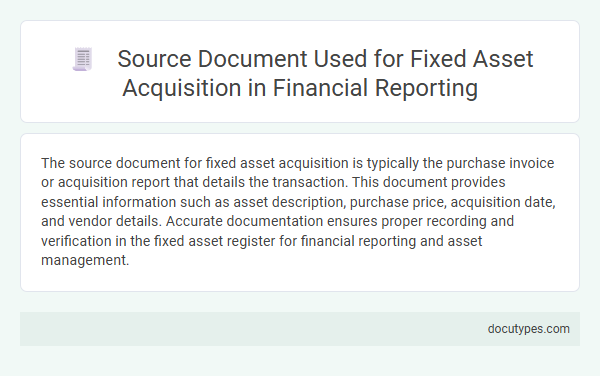The source document for fixed asset acquisition is typically the purchase invoice or acquisition report that details the transaction. This document provides essential information such as asset description, purchase price, acquisition date, and vendor details. Accurate documentation ensures proper recording and verification in the fixed asset register for financial reporting and asset management.
Introduction to Source Documents in Fixed Asset Acquisition
Source documents for fixed asset acquisition provide the original evidence and details of the transaction. These documents typically include purchase orders, invoices, and delivery receipts, which help verify the acquisition cost and asset specifics. Accurate source documents ensure proper recording and tracking of fixed assets in financial statements.
Importance of Source Documents in Financial Reporting
The source document for fixed asset acquisition is typically the purchase invoice or acquisition receipt. This document provides detailed evidence of the transaction, including cost, date, and vendor information.
Source documents are crucial in financial reporting as they ensure accuracy and transparency in recording asset acquisitions. They serve as verifiable proof for auditors and support compliance with accounting standards.
Types of Source Documents for Fixed Asset Purchases
The source document for fixed asset acquisition is essential for verifying and recording the purchase of long-term assets. These documents provide legal evidence and financial details necessary for asset management and accounting.
- Invoice - An invoice from the supplier details the purchase price, date, and description of the fixed asset acquired.
- Purchase Order - A purchase order confirms the authorized request and approval for the acquisition of the fixed asset.
- Bill of Sale - A bill of sale legally transfers ownership of the fixed asset from the seller to the buyer, serving as proof of purchase.
Purchase Invoices as Primary Evidence
The source document for fixed asset acquisition is essential for verifying the authenticity of the transaction. Purchase invoices serve as the primary evidence in this process, providing detailed information about the asset acquired.
- Purchase Invoice Details - It includes the vendor's name, invoice date, asset description, quantity, and price, ensuring accurate record-keeping.
- Proof of Ownership - The invoice confirms the transfer of ownership from the seller to you, documenting the acquisition legally and financially.
- Audit and Compliance - Purchase invoices are critical for audits, supporting depreciation calculations and compliance with accounting standards.
Supplier Contracts and Agreements
The source document for fixed asset acquisition primarily includes supplier contracts and agreements that detail the terms and conditions of the transaction. These documents serve as legal evidence of ownership and support the asset's entry into the accounting records.
- Supplier Contracts - These documents specify the purchase price, payment terms, delivery schedules, and warranty conditions related to the fixed asset.
- Agreements - Formal agreements outline responsibilities, liabilities, and compliance requirements between the buyer and supplier for the fixed asset acquisition.
- Invoice Reference - Supplier contracts often accompany invoices which provide verification of the transaction amount and confirmation of asset receipt.
Supplier contracts and agreements are essential for ensuring accurate fixed asset recording and legal validation within financial reporting systems.
Asset Registration and Ownership Certificates
The source document for fixed asset acquisition primarily includes asset registration forms and ownership certificates. These documents serve as official proof of asset ownership and are essential for accurate record-keeping.
Asset registration records detailed information about the fixed asset, such as description, purchase date, and cost. Ownership certificates validate your legal rights to the asset and are vital for auditing and compliance purposes. Maintaining these documents ensures transparency and supports efficient asset management throughout the asset's lifecycle.
Payment Vouchers and Bank Statements
| Source Document | Description | Role in Fixed Asset Acquisition |
|---|---|---|
| Payment Vouchers | Payment Vouchers are formal documents that record the authorization and details of payment transactions related to fixed asset purchases. These include information such as the vendor name, payment amount, date, and approval signatures. | They serve as proof for the approval and execution of payments for fixed asset acquisition. Payment Vouchers validate the outflow of funds and support accounting entries for asset recording. |
| Bank Statements | Bank Statements are official records issued by financial institutions that show all bank transactions, including payments made for fixed assets. They list transaction dates, amounts, and recipient details. | Bank Statements confirm the actual disbursement of funds from the company's bank account. They reconcile with payment vouchers to verify the payment authenticity and ensure accuracy in fixed asset cost recording. |
Goods Received Notes (GRN) and Delivery Receipts
What is the source document for fixed asset acquisition? The primary source documents for fixed asset acquisition are Goods Received Notes (GRN) and Delivery Receipts. These documents serve as evidence of the receipt and condition of assets purchased, ensuring accurate recording in financial and asset management systems.
Role of Source Documents in Audit Compliance
The source document for fixed asset acquisition is typically the purchase invoice or contract that details the transaction. These documents serve as essential evidence supporting the authenticity and valuation of the asset in financial records. In audit compliance, source documents play a critical role by providing auditors with verifiable proof of asset acquisition, ensuring accuracy and transparency in financial reporting.
What Is the Source Document for Fixed Asset Acquisition? Infographic

